
E-mail: font@focusonnature.com
Phone: Toll-free in USA 1-888-721-3555
or 302/529-1876
 |
PO
Box 9021, Wilmington, DE 19809, USA E-mail: font@focusonnature.com Phone: Toll-free in USA 1-888-721-3555 or 302/529-1876 |
A Focus On Nature Tour
in
TEXAS
In the
LATE WINTER,
EARLY SPRING
FOR
bIRDS
including the
Whooping Crane
Also
BUTTERFLIES
& OTHER NATURE
From rockport on the gulf
to the lower rio grande valley
March 14-22, 2016
(tour FON/TX-1
'16)
To include, at a prime-time
for Texas birding,
many birds.
Among the specialties:
the GOLDEN-CHEEKED WARBLER, GREEN JAY,
and BUFF-BELLIED HUMMINGBIRD.
Notable birds in
the southern Texas during recent years have included
these normally seen in Mexico:
Crimson-collared Grosbeak, White-throated Robin, Social Flycatcher,
Rufous-capped Warbler, Golden-crowned Warbler, Tropical Parula,
Blue Bunting, and Green-breasted Mango
(Some birds such as these may be seen during this tour)
Tour to be led by Armas
Hill
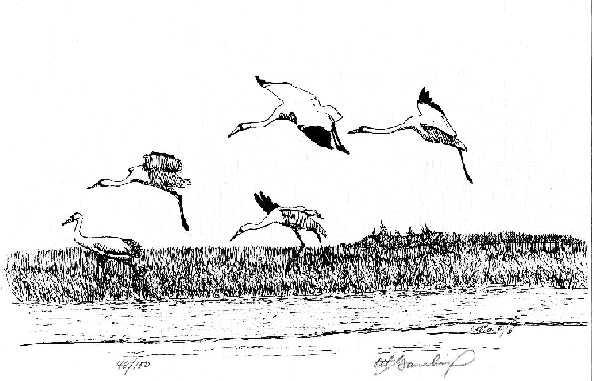
A Drawing of Whooping Cranes at
Aransas in Texas,
given as a gift to Armas Hill from the illustrator, Charles Gambill
Links:
A List & Photo Gallery of Texas Birds in 2 Parts:
Part
#1: Quails to Becard
Part
#2: Flycatchers to Buntings
Lists of Other Texas Wildlife (each with
some photos)
Mammals Butterflies
Dragonflies & Damselflies
Amphibians & Reptiles
Texas Wildflowers Plants of the Desert & some nearby habitats (with some photos)
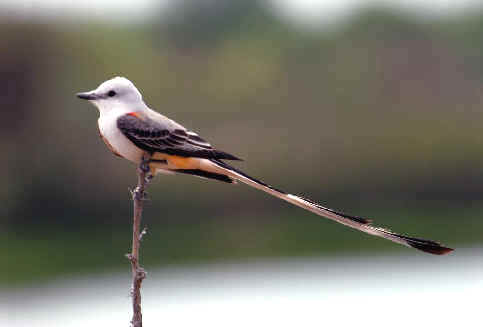
Itinerary (price
follows):
Mon:
Mar 14 Arrival in Corpus Christi,
Texas. Travel north to the coastal
town of Rockport, to be our base for
the first few days of the tour.
In the afternoon, we'll visit the the Aransas
National Wildlife Refuge (a place renowned for Whooping
Cranes from fall thru spring). The refuge, of over 50,000 acres, is
on the Blackjack Peninsula, and
incorporates a number of different habitats wooded sand dunes, brushlands, oak
"mottes", grass meadows, cordgrass prairies, tidal marshes, freshwater
ponds, and marine bays. About 8,500 acres is open to the public, and there is a
16-mile auto loop-road. Nesting
birds on the refuge include: Pauraque, White-tailed Hawk, Northern Crested
Caracara, Purple Gallinule, Wilson's Plover, and Cassin's Sparrow.
Other wildlife of the refuge include: American Alligator, White-tailed Deer,
Collared Peccary (Javelina), Armadillo, and Coyote.
The first of two overnights in Rockport.
Tue: Mar 15
This morning, a boat-ride in the marshes near the Aransas Refuge for another look at the Whooping Cranes. We should get a good, close look. A number of birds, of various sorts, will also be seen from the boat.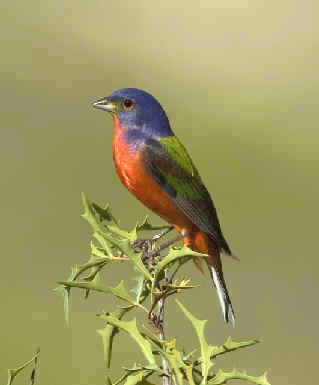
male Painted Bunting
(photo by Clair de
Beauvior)
Wed: Mar 16
Before we leave Rockport, we'll visit Goose Island State Park, where we could see Reddish Egret, Least Bittern, Roseate Spoonbill, Black-bellied Whistling-Duck, Clapper Rail, Gull-billed and Sandwich and other Terns, and Seaside Sparrow.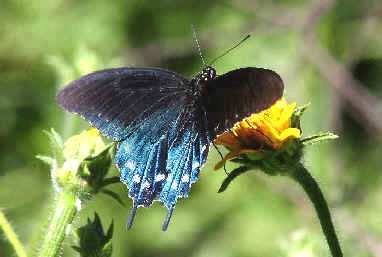
In the Gulf Coast region of
Texas,
one of the more common butterflies is the Pipevine Swallowtail (above).
Mid-day this day, we'll travel south and west to Kingsville,
where we'll do some birding at the King Ranch,
said to be the largest privately-owned ranch in the world, with more than
800,000 acres.
Among bird species in the Kingsville area, near the northern limit of their
nesting range, are White-tailed Hawk, Green Jay, Great Kiskadee,
Brown-crested Flycatcher, Audubon's Oriole, and Buff-bellied Hummingbird.
Other nesting species in the area include: both Black-chinned and Ruby-throated
Hummingbirds, Common Ground-Dove, and Hooded Oriole.
From the King Ranch, we travel south along Highway #77, with some birding stops
enroute, to Weslaco, where we'll spend the night.
Along Highway #77, we should, along the way, see some nice raptors along
with White-tailed Hawk, there should be the Harris' Hawk and the Northern
Crested-Caracara.
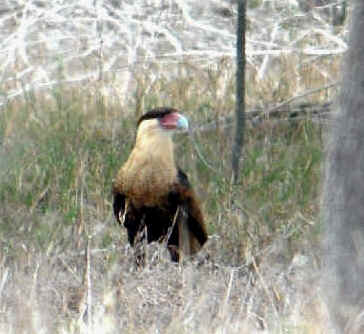
Northern Crested Caracara
(photo by Howard
Eskin)
Thu: Mar 17
This day, we'll be
birding at the Laguna Atascosa National Wildlife
Refuge, east of Harlingen. It is a large refuge of over 45,000
acres with a variety of habitats including mostly coastal prairie with grass and
cacti in the low places, and thick brush on the higher ground. 7,000 acres of
the refuge are ponds and marshes.
Various species of geese and Sandhill Cranes can be present in large numbers,
and about two dozen species of ducks occur, including, regularly, Black-bellied
Whistling Duck and Mottled Duck, and rarely, Masked Duck. Particularly plentiful
can be Redheads.
In addition to waterfowl, the refuge also hosts shorebirds, and herons and
egrets, including the Reddish Egret.
Other birds found in the refuge include: Harris' Hawk, Pauraque, Great Kiskadee,
Long-billed and Curve-billed Thrashers, and Olive Sparrow, just to name a few.
Our second of three overnights in
Weslaco.
Fri: Mar 18 Birding in the the Lower Rio Grande Valley,
one of the foremost areas of the US for birds. We'll see many, some of which
only spill over a relatively short distance from Mexico.
In Brownsville, for example, Red-crowned
Parrots and Green Parakeets occur. At the infamous Brownsville
Dump, we'll look for the Tamaulipas (formerly Mexican)
Crow. It may not be easy to find there, but Chihuahuan Ravens
should be common.
Two places renowned for birding the Santa
Ana National Wildlife Refuge and the
Bentsen-Rio Grande Valley State Park.
The Santa Ana Refuge has been
called the "Gem of the National Wildlife Refuge System".
Some of the
"Mexican species" of birds that occur there are easy to see such as
the Altamira Oriole, Green Jay, Plain Chachalaca (also easy to hear!),
and White-tipped Dove.
Other "Mexican birds" that are normally
across the border can occur as "accidentals", including Masked
Duck, Northern Jacana, Rose-throated Becard, Northern Beardless Tyrannulet,
Rufous-backed Robin, Yellow-green Vireo, and Blue Bunting.
More likely to be seen are Black-bellied Whistling-Duck, Harris' Hawk, Purple
Gallinule, Pauraque, Great Kiskadee, Brown-crested Flycatcher, Tropical Parula, and Bronzed Cowbird. Hook-billed Kite, Gray
Hawk, and Clay-colored Robin can also be seen in the area.
Some of these birds also occur at the Bentsen State
Park, which we'll visit in
the afternoon. But there are some birds at easier to see at Bentsen than at
Santa Ana. These include Red-billed Pigeon and Elf Owl. Groove-billed
Anis can be quite common. Rarities at Bentsen have included: Roadside
Hawk, Masked Tityra, and Ruddy Quail-Dove. As at Santa Ana, Hook-billed
Kite and Blue Bunting can also occur.
After a bird-filled day, overnight again in Welaco.
Sat: Mar 19
After some additional birding at Bentsen, in the morning, we'll go further west in the Rio Grande Valley, to the bird in the area of the Falcon Dam and nearby Falcon State Park. Enroute, we'll stop at the Santa Margarita Ranch to look for the Brown Jay.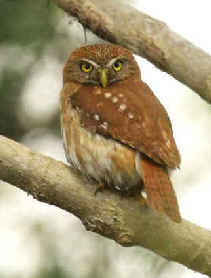
Ferruginous
Pygmy Owl (above),
Greater Roadrunner (below)
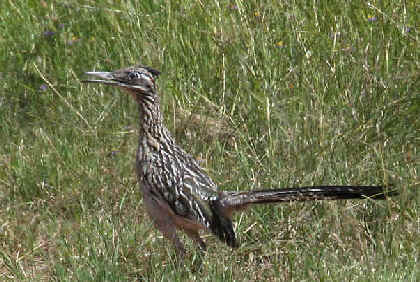
Sun: Mar 20 We'll
do some morning birding this day (as we like to do morning birding every day)
in Laredo at the grounds of the
Laredo Junior College and the nearby Lake
Casa Blanca Park.
But then we'll be driving north
from Laredo toward the Edwards Plateau, where our
prime birding objective with be a specialty of that region of junipers and oaks, the Golden-cheeked
Warbler.
The overnights of Thu Mar 6 & Fri Mar 7 to be in
Uvalde, near the Edwards
Plateau.
After dark, during either one, or both of these nights, we'll look for various nocturnal birds,
mammals, and other
wildlife.
Mon:
Mar 21 A
full-day of birding in the Edwards Plateau,
where the avian specialty just mentioned, the Golden-cheeked
Warbler, arrives in early March, from Mexico and Central America, coming to
Texas to breed. Not only is the Edwards Plateau "the
place" for them in Texas, it's "the place" for them in
the United States.
This day we should enjoy seeing an assortment of wildlife,
with birds of various kinds, some animals, butterflies, and
maybe an amphibian or reptile in addition to a variety of plants.
Tue: Mar 22 After
some early-morning birding, our last for the tour, we'll head for the airport at
San Antonio for our afternoon departure for home.
Price: $1,795 per
person, based upon double occupancy
Single supplement: $215
Includes:
• All overnight accommodations.
• Meals, except dinners.
• Ground transportation in
Texas.
• Services of the birding
guide.
Does not
include:
Dinners. Drinks. Items of a personal nature.
Air fare. Airport
tax. Gratuities.
A deposit of
$500, per person,
is required to assure a place on each or either of the tours.
![]()